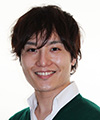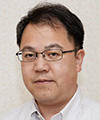 |
|||||||||||||||||||||||
|
|
|||||||||||||||||||||||
|
Feature Articles: Creativity and Technology—Designing for an Unknown Future Vol. 19, No. 9, pp. 39–45, Sept. 2021. https://doi.org/10.53829/ntr202109fa4 Developing AI that Pays Attention to Who You Want to Listen to: Deep-learning-based Selective Hearing with SpeakerBeamAbstractIn a noisy environment such as a cocktail party, humans can focus on listening to a desired speaker, an ability known as selective hearing. In this article, we discuss approaches to achieve computational selective hearing. We first introduce SpeakerBeam, which is a neural-network-based method for extracting speech of a desired target speaker in a mixture of speakers, by exploiting a few seconds of pre-recorded audio data of the target speaker. We then present our recent research, which includes (1) the extension to multi-modal processing, in which we exploit video of the lip movements of the target speaker in addition to the audio pre-recording, (2) integration with automatic speech recognition, and (3) generalization to the extraction of arbitrary sounds. Keywords: speech processing, deep learning, SpeakerBeam, selective hearing 1. IntroductionHumans can listen to the person they want to (i.e., a target speaker) in a noisy environment such as a cocktail party by focusing on clues about that speaker such as her/his voice characteristics and the content of the speech. We call this ability selective hearing. It has been the goal of speech-processing researchers to reproduce a human’s selective hearing ability. When several people speak together, the speech signals of the speakers tend to overlap, creating a speech mixture. It is difficult to distinguish the speech of the target speaker from that of the other speakers in such a mixture since all speech signals share similar characteristics. One conventional approach to address this issue is to use blind source separation (BSS), which separates a speech mixture into the source speech signals of each speaker. Research on BSS has made tremendous progress. However, BSS algorithms usually (1) require knowing or estimating the number of speakers speaking in the speech mixture and (2) introduce an arbitrary permutation between the separated outputs and speakers, i.e., we do not know which output of BSS corresponds to the target speaker. These limitations of BSS can impede the deployment of BSS technologies in certain practical applications. Target-speech extraction is an alternative to BSS that has attracted attention. Instead of separating all speech signals, target-speech extraction focuses on extracting only the speech signal of the target speaker from the mixture. It uses clues about the target speaker to identify and extract that speaker in the mixture [1, 2, 3]. Several speaker clues have been proposed such as an embedding vector that is derived from a pre-recorded enrollment utterance and represents the voice characteristics of the target speaker (audio clue) or video data showing the lip movements of the target speaker (video clue). Using such speaker clues, these speech extraction methods focus on only extracting the target speaker without requiring the number of speakers in the mixtures. The output of the methods corresponds to the target speaker, avoiding any permutation ambiguity. Therefore, target-speech extraction naturally avoids the limitations of BSS. In this article, we briefly review the audio-clue-based target-speech extraction method, SpeakerBeam. We experimentally show one of its limitations, i.e., performance degrades when extracting speech in mixtures of speakers with similar voice characteristics. We then introduce the multimodal (MM) extension of SpeakerBeam, which is less sensitive to the above problem. Finally, we discuss how the principles of target-speech extraction can be applied to other speech-processing problems and expand on future work directions to achieve human’s selective hearing ability. 2. SpeakerBeam: Neural-network-based target-speech extraction with audio cluesFigure 1 is a schematic of SpeakerBeam, which is a neural network (NN)-based target-speech extraction method that exploits audio clues of the target speaker. SpeakerBeam consists of two NNs. The speaker-characteristic-computation NN accepts an enrollment recording of the voice of the target speaker of about 10 seconds and computes a speaker-embedding vector representing her/his voice characteristics. The target-speech-extraction NN accepts the mixture signal and speaker-embedding vector and outputs the speech signal of the target speaker without the voice of the other speakers. The speaker-embedding vector informs the target-speech-extraction NN which of the speakers from the mixture to extract. These two networks are trained jointly to obtain speaker-embedding vectors optimal for target-speech extraction. SpeakerBeam was the first method for target-speech extraction based on audio clues representing the voice characteristics of the target speaker.
We conducted experiments to evaluate SpeakerBeam’s performance using two-speaker mixtures generated from a corpus of English read speech utterances. Figure 2(a) shows the extraction performance of SpeakerBeam measured with the signal-to-distortion ratio (SDR). The higher the SDR the better the extraction is. SpeakerBeam achieved high extraction performance on average with an SDR of more than 8 dB. However, by breaking down this number in terms of performance for mixtures of speakers of the same or different sexes, we observed a severe degradation in performance by more than 2 dB when extracting speech from same-sex mixtures. This reveals the difficulty of SpeakerBeam to identify and extract the target speech when the speakers in the mixture have relatively similar voice characteristics, which occurs more often with same-sex mixtures. One approach to address this issue is to rely on other clues than audio clues to carry out target-speech extraction such as video clues that do not depend on voice characteristics.
3. MM SpeakerBeamIn parallel to audio clues, others have proposed using video clues to carry out target-speech extraction. For example, Ephrat et al. [3] used a video recording of the face and lip movements of the target speaker to extract speech. Their method uses a pre-trained NN, such as FaceNet, to extract features or face-embedding vectors representing the characteristics of the face of the target speaker. These face-embedding vectors form a dynamic representation of the lip movements of the target speaker speaking in the mixture. They are fed to a target-speech-extraction NN, similar to that of SpeakerBeam, to identify and extract the speech signal in the mixture that corresponds to those lip movements. The video clues do not depend on the voice characteristics of the target speaker. Therefore, video-clue-based approaches can be used even when the speakers have similar voice characteristics. For example, in an extreme case, Ephrat et al. [3] showed that video-clue-based approaches could even extract speech in a mixture of two speech utterances of the same speaker as long as the speech content, thus lip movements, were different. However, video clues are sensitive to obstructions, i.e., when the mouth of the target speaker is hidden from the video, which often occurs. We previously proposed an extension of SpeakerBeam called MM-SpeakerBeam that can exploit multiple clues [4, 5]. For example, by using both audio and video clues, we can combine the benefits of audio- and video-clue-based target-speech extraction, i.e., robustness to obstructions in the video thanks to the audio clue and handling of mixtures of speakers with similar voices thanks to the video clue. Figure 3 is a schematic of MM-SpeakerBeam. MM-SpeakerBeam exploits both video and audio clues and uses a face-characteristic-computation NN to extract a time sequence of face-embedding vectors from the video clue, as in Ephrat et al.’s study [3], and a speaker-characteristic-computation NN to extract speaker-embedding vectors, as in audio-clue-based SpeakerBeam. MM-SpeakerBeam includes a clue-selection mechanism to select the speaker clues based on clue reliability, which dominantly exploits audio clues when the face is obstructed in the video and the video clues when the speakers have similar voice characteristics. We implemented the clue-selection mechanism using a similar attention mechanism to that initially proposed for neural machine translation. The target-speech-extraction NN is similar to that of SpeakerBeam. Thanks to the clue-selection mechanism, we can combine clues optimally depending on the situation, making MM-SpeakerBeam more robust than target-speech-extraction methods relying on a single modality.
Figure 2(b) shows the speech-extraction performance of MM-SpeakerBeam. We can see that the overall performance improves and that the largest improvement was achieved for same-sex mixtures. These results reveal that by exploiting multiple modalities (here audio and video), MM-SpeakerBeam can achieve more stable performance. We refer the readers to our demo webpage [6] to listen to various examples of processed signals. 4. Extension to other speech-processing tasksWe can apply the principle of SpeakerBeam to speech-processing tasks other than target-speech extraction. For example, after we proposed SpeakerBeam, others have used a similar method to achieve target-speaker voice-activity detection (TS-VAD) [7], which consists of estimating the start and end timing of speech of the target speaker in a mixture. TS-VAD is an important technology when developing automatic meeting-transcription or minute-generation systems as it enables us to determine who speaks when in a conversation. The use of target-speaker clues is very effective for voice-activity detection under challenging conditions [7]. Another extension of SpeakerBeam consists of target-speech recognition, which outputs the transcription of the words spoken by the target speaker directly, without any explicit speech-extraction step [8]. 5. Future perspectivesThere are various potential applications for target-speech extraction such as for hearing aids, hearables or voice recorders that can enhance the voice of the speaker of interest, and smart devices that respond only to a designated speaker. Target-speech extraction can also be useful for automatic meeting-transcriptions or minute-generation systems. We plan to extend the capability of SpeakerBeam to get closer to human selective hearing ability, thus open the door for novel applications. One of our recent research interests is to extend the extraction capabilities of SpeakerBeam to arbitrary sounds. Figure 4 illustrates the concept of our recently proposed universal sound selector [9]. This system uses clues indicating which sound categories are of interest, instead of audio or video clues. With this system, we can develop hearing devices that can extract different important sounds from the environment (e.g., woman or siren in the figure) while suppressing other disturbing sounds (dog barking, car noise, or man speaking) depending on the user or situation. Interested readers can find a demo of this system on our webpage [10].
Finally, humans can focus on a conversation depending on its content. A well-known example is that we can easily pick up when someone is saying our name at a cocktail party. Humans can thus exploit more abstract clues, as well as audio and video, to achieve selective listening such as the topic of a conversation or other abstract concepts. To achieve human selective hearing, we should extend SpeakerBeam to speech extraction on the basis of such abstract concepts. This introduces two fundamental research problems. First, how to represent abstract speech concepts. We have made progress in this direction [11]. The second problem consists of how to extract the desired speech signal on the basis of such abstract concept representations. We will tackle these problems in our future research. References
|
|||||||||||||||||||||||



















